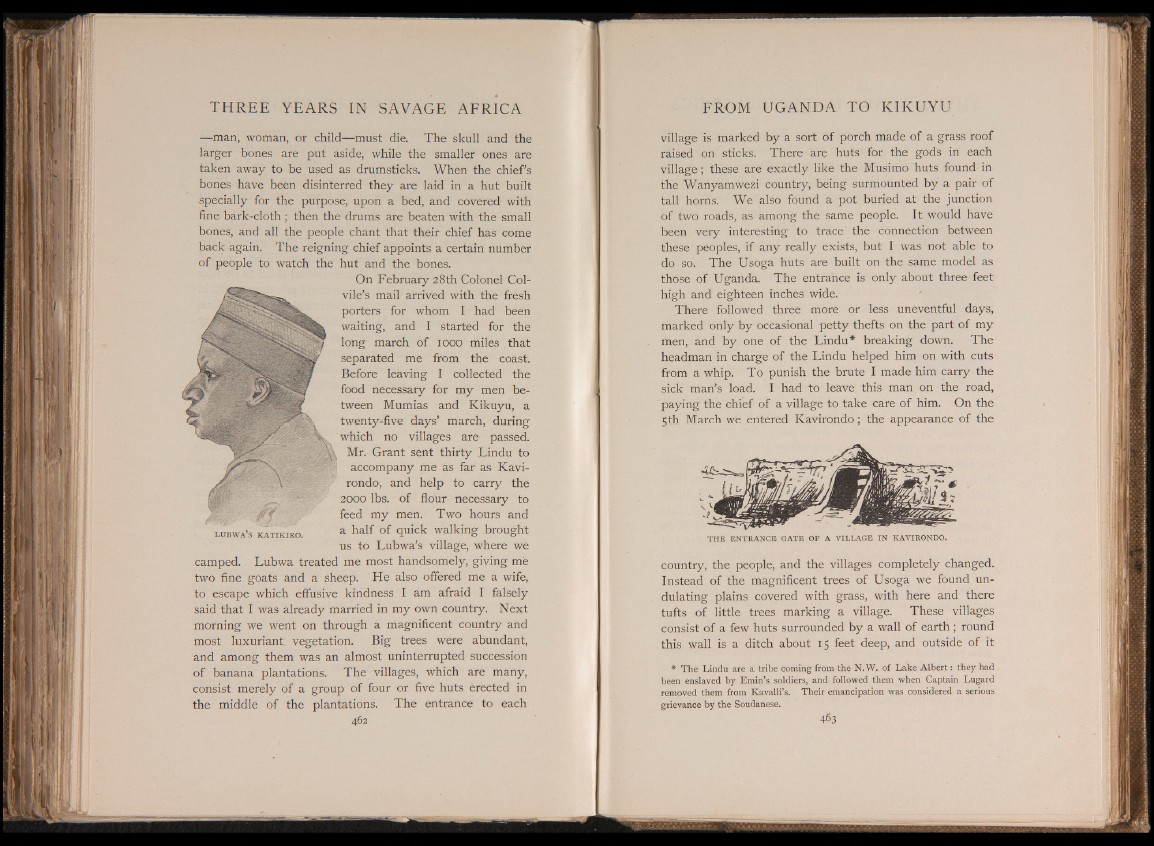
—man, woman, or child—must die. The skull and the
larger bones are put aside, while the smaller ones are
taken away to be used as drumsticks. When the chief’s
bones have been disinterred they are laid in a hut built
specially for the purpose, upon a bed, and covered with
fine bark-cloth; then the drums are beaten with the small
bones, and all the people chant that their chief has come
back again. The reigning chief appoints a certain number
of people to watch the hut and the bones.
On February 28th Colonel Col-
vile’s mail arrived with the fresh
porters for whom I had been
waiting, and I started for the
long march of 1000 miles that
separated me from the coast.
Before leaving I collected the
food necessary for my men between
Mumias and Kikuyu, a
twenty-five days’ march, during
which no villages are passed.
Mr. Grant sent thirty Lindu to
accompany me as far as Kavi-
rondo, and help to carry the
2000 lbs. of flour necessary to
feed my men. Two hours and
l u b w a ’ s k a t i k i r o . a half of fluick walkin£ brought
us to Lubwa’s village, where we
camped. Lubwa treated me most handsomely, giving me
two fine goats and a sheep. He also offered me a wife,
to escape which effusive kindness I am afraid I falsely
said that I was already married in my own country. Next
morning we went on through a magnificent country and
most luxuriant, vegetation. Big trees were abundant,
and among them was an almost uninterrupted succession
of banana plantations. The villages, which are many,
consist merely of a group of four or five huts erected in
the middle of the plantations. The entrance to each
462
village is marked by a sort of porch made of a grass roof
raised on sticks. There ■ are huts for the gods in each
village; these are exactly like the Musimo huts found in
the Wanyamwezi country, being surmounted by a pair of
tall horns. We also found a pot buried at the junction
of two roads, as among the same people. It would have
been very interesting to trace the connection between
these peoples, if any really exists, but I was not able to
do so. The Usoga huts are built on the same model as
those of Uganda. The entrance is only about three feet
high and eighteen inches wide.
There followed three more or less uneventful days,
marked only by occasional petty thefts on the part of my
men, and by one of the Lindu* breaking down. The
headman in charge of the Lindu helped him on with cuts
from a whip. To punish the brute I made him carry the
sick man’s load. I had to leave this man on the road,
paying the chief of a village to take care of him. On the
5 th March we entered Kavirondo; the appearance of the
THE ENTRANCE GATE OF A V IL LA G E IN KAVIRONDO.
country, the people, and the villages completely changed.
Instead of the magnificent trees of Usoga we found undulating
plains covered with grass, with here and there
tufts of little trees marking a village. These villages
consist of a few huts surrounded by a wall of earth ; round
this wall is a ditch about 15 feet deep, and outside of it
* The Lindu are a tribe coming from the N.W. of Lake Albert: they had
been enslaved by Emin’s soldiers, and followed them when Captain Lugard
removed them from Kavalli’s. Their emancipation was considered a serious
grievance by the Soudanese.